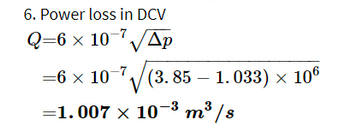34. The speed of a hydraulic cylinder is controlled by means of a series pressure-compensated flow control valve, as shown in the given circuit. Given: Pump: V, - 25 cm'/rev п 1000 грm n, - 0.95 n. - 0.93 7, - 1 Directional control valve: Pa, Pla Q= 6×107JAP Relief valve: Cracking pressure = 6 MPa Override pressure 0 Hydraulic cylinder: P, f= 2000 Ns/m v = 0.1 m/s F = 9000 N Piston diameter = 60 mm Rod diameter = 25 mm No inner leakage Calculate: P=0 P, P, P, P Qu Qy Power losses in the DCV Power losses in the FCV (M- Pump real flow rate
34. The speed of a hydraulic cylinder is controlled by means of a series pressure-compensated flow control valve, as shown in the given circuit. Given: Pump: V, - 25 cm'/rev п 1000 грm n, - 0.95 n. - 0.93 7, - 1 Directional control valve: Pa, Pla Q= 6×107JAP Relief valve: Cracking pressure = 6 MPa Override pressure 0 Hydraulic cylinder: P, f= 2000 Ns/m v = 0.1 m/s F = 9000 N Piston diameter = 60 mm Rod diameter = 25 mm No inner leakage Calculate: P=0 P, P, P, P Qu Qy Power losses in the DCV Power losses in the FCV (M- Pump real flow rate
Elements Of Electromagnetics
7th Edition
ISBN:9780190698614
Author:Sadiku, Matthew N. O.
Publisher:Sadiku, Matthew N. O.
ChapterMA: Math Assessment
Section: Chapter Questions
Problem 1.1MA
Related questions
Question

Transcribed Image Text:34. The speed of a hydraulic cylinder is controlled by means of a series
pressure-compensated flow control valve, as shown in the given circuit.
Given:
Pump:
V, = 25 cm'/rev
n = 1000 rpm
n, = 0.95
n. = 0.93
n. = 1
P,Q,
Pa,
Directional control valve:
Q= 6x10-7 VAP
Relief valve:
Cracking pressure = 6 MPa
P.
Override pressure = 0
P=0
Hydraulic cylinder:
f= 2000 Ns/m
v = 0.1 m/s
F= 9000 N
Piston diameter = 60 mm
Rod diameter = 25 mm
No inner leakage
Calculate:
P=0
P, P, P, Pp Qu Qy
Power losses in the DCV
M)
Power losses in the FCV
Pump real flow rate
Expert Solution
This question has been solved!
Explore an expertly crafted, step-by-step solution for a thorough understanding of key concepts.
This is a popular solution!
Trending now
This is a popular solution!
Step by step
Solved in 2 steps

Follow-up Questions
Read through expert solutions to related follow-up questions below.
Follow-up Question
I confused following this picture why (3.85-1.033)*10^-6

Transcribed Image Text:6. Power loss in DCV
Q=6 × 10-7√√Ap
=6 × 10-7√(3.85 – 1.033) × 106
-3
=1.007 × 10-³ m³/s
Solution
Knowledge Booster
Learn more about
Need a deep-dive on the concept behind this application? Look no further. Learn more about this topic, mechanical-engineering and related others by exploring similar questions and additional content below.Recommended textbooks for you

Elements Of Electromagnetics
Mechanical Engineering
ISBN:
9780190698614
Author:
Sadiku, Matthew N. O.
Publisher:
Oxford University Press

Mechanics of Materials (10th Edition)
Mechanical Engineering
ISBN:
9780134319650
Author:
Russell C. Hibbeler
Publisher:
PEARSON

Thermodynamics: An Engineering Approach
Mechanical Engineering
ISBN:
9781259822674
Author:
Yunus A. Cengel Dr., Michael A. Boles
Publisher:
McGraw-Hill Education

Elements Of Electromagnetics
Mechanical Engineering
ISBN:
9780190698614
Author:
Sadiku, Matthew N. O.
Publisher:
Oxford University Press

Mechanics of Materials (10th Edition)
Mechanical Engineering
ISBN:
9780134319650
Author:
Russell C. Hibbeler
Publisher:
PEARSON

Thermodynamics: An Engineering Approach
Mechanical Engineering
ISBN:
9781259822674
Author:
Yunus A. Cengel Dr., Michael A. Boles
Publisher:
McGraw-Hill Education

Control Systems Engineering
Mechanical Engineering
ISBN:
9781118170519
Author:
Norman S. Nise
Publisher:
WILEY

Mechanics of Materials (MindTap Course List)
Mechanical Engineering
ISBN:
9781337093347
Author:
Barry J. Goodno, James M. Gere
Publisher:
Cengage Learning

Engineering Mechanics: Statics
Mechanical Engineering
ISBN:
9781118807330
Author:
James L. Meriam, L. G. Kraige, J. N. Bolton
Publisher:
WILEY